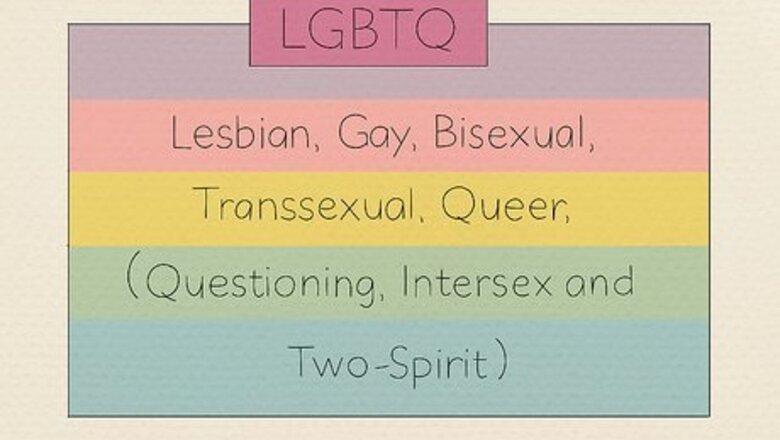
views
- "Sex" is a label assigned at birth, "gender" is an internal sense of who you are, and "sexual orientation" is your relational attraction to others.
- The LGBT+ community has faced stigma and discrimination in the form of hate speech as well as trauma from harmful programs like "conversion therapy."
- The best way to contribute to mental wellness, higher self-esteem, and life satisfaction among LGBT+ individuals is to practice tolerance and acceptance.
- Allies can become more effective support figures to LGBTQ+ people by actively listening to them and implementing policies that serve their best interests.
Key Concepts
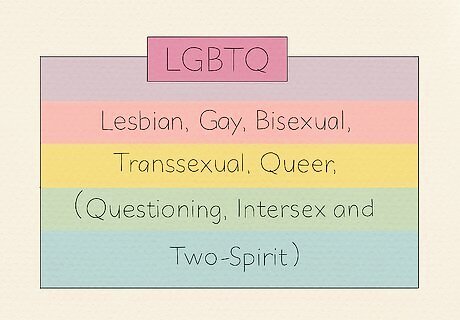
LGBT+ people use a variety of terms to describe themselves. To broaden your understanding of those that fall outside the scope of heteronormativity—in order words, the way in which society presents heterosexuality as the "norm"—familiarize yourself with key LGBT+ terminology that relates to sex, sexual orientation, and gender. Here are some terms to help you gain a more nuanced comprehension of LGBTQIS-2 matters: Sex: A label you're assigned at birth (i.e., "male," "female," or "intersex"—a combination traits that don't fit the typical male/female binary). Gender: An internal sense of who you are (i.e., "male," "female," or "non-binary"—neither male nor female). Transgender: A gender that differs from what was assigned to you at birth. Cisgender: A gender that corresponds with what you were assigned at birth. Gender expression: The way in which you represent your gender to others (e.g., what you wear, how you act, the interests you pursue). Sexual orientation: Your emotional, sexual, or relational attraction to others (e.g., "gay/lesbian" to describe attraction to the same sex/gender, "bisexual" to describe attraction to multiple sexes/genders; "asexual" to describe a lack of attraction to anyone, etc.) Queer: An umbrella term for anyone who either doesn't identify as heterosexual or who doesn't identify as cisgender or who is neither heterosexual nor cisgender. Questioning: When you are unsure or exploring your sexual orientation or gender. Two-Spirit: The Native American term for tribe members who have a "two-spirit" identity and experience a unique, non-Western, and indigenous relationship with gender and sexual orientation. LGBTQIS-2: Lesbian, Gay, Bisexual, Transsexual, Queer, Questioning, Intersex, and/or Two-Spirit.
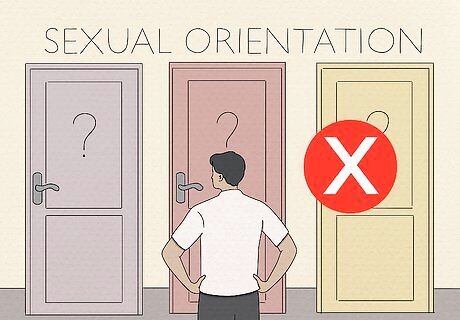
People do not "choose" their sexual orientation. Fight back against any misinformation that claims being LGBTQIS-2 is a "choice" or a "lifestyle." These false beliefs harm LGBTQIS-2 individuals because they create a stigma and imply that LGBTQIS-2 people can "change" if they decide to. To demonstrate respect for LGBTQIS-2 individuals and their humanity, acknowledge that they are living their truth and following their natural instincts. There is absolutely no evidence that external factors, like home life, influence gender or sexual orientation. Gender expression is a choice, but it's a way to affirm—validate and honor—the gender someone already has. In some cases, people change their gender expression to "pass" as heteronormative, but this is a red flag that the environment they're in isn't welcoming or accepting. To promote a society where everyone is free to express their gender in a way that affirms them, voice the tolerant stance that non-heteronormativity is not a "choice."

"Conversion therapy" is harmful and leads to poor mental health. LGBTQIS-2 people have reported that "conversion therapy" left them with significant trauma. Conversion therapy is a toxic type of program—usually in the form of one-on-one sessions or camps—that tries to force people to change their sexual orientation. Based on accounts from survivors, the LGBT+ community would be well served if society eliminated conversion camps altogether. In fact, the America Psychological Association (APA) has adopted a resolution that states that all mental health professionals should abstain from telling their clients to change their sexual orientation. Identifying as LGBTQIS-2 cannot be "cured," but reinforcing the harmful belief that it can be leads to mental health challenges, including internal battles, self-harm, and a lack of self-acceptance.

LGBT+ individuals thrive when they're openly accepted. Push back against any limiting beliefs or cognitive biases that LGBTQIS-2 people should "adjust" so they can "fit" into heteronormative society. Champion the idea that those who identify as LGBTQIS-2 are equally as worthy of respect, courtesy, and accommodation as anyone else. Above all, celebrate a world in which people go beyond just tolerating each other and instead actively make space for one another. When LGBTQIS-2 individuals receive open acceptance from friends, relatives, and community members, they're much more likely to enjoy healthy, happy, and successful lives.
The Process of “Coming Out”

Some people might only “come out” to themselves. "Coming out" is the process of someone vocalizing that they're LGBTQIS-2. This is a deeply personal choice, and only a LGBTQIS-2 person can determine if coming out is best for them. Based on their unique circumstances, they may decide that coming out is empowering or that it doesn't serve them. Respect that there's no "timeline" or requirement for a LGBTQIS-2 individual to express their identity. Avoid telling or accidentally pressuring someone you think might be LGBTQIS-2 to come out—that denies their autonomy and you might be mistaken. A LGBTQIS-2 person might not be ready to come out to themselves or that they might not be interested in labeling themselves at all. If someone who might be LGBTQIS-2 seems to come out to you, remain courteous but neutral. For example, if they say, "I've been meaning to share something about myself," you might reply with a comment like, "I'm always here to listen. What's on your mind?"

LGBT+ people look for cues before they come out to a community. While a LGBTQIS-2 person might fully embrace who they are, they might be skeptical or worried about how others will perceive them. Accept that this is a totally normal reaction considering the stigma or pushback they might experience. To determine if it's safe to disclose their identity, they might listen to how people speak or how they treat other LGBTQIS-2 individuals. If someone who's LGBTQIS-2 confides in you, reassure them that you empathize with their situation. They might listen to the language people use or the political stances they share. They may watch for how others interact with other LGBTQIS-2 people and check to see if they form close friendships with those in the LGBTQIS-2 community. If they notice signs of discrimination and aren't comfortable with coming out, they might make a comment like, "I'm not sure how tolerant everyone is. Sometimes they make some really offensive comments."

LGBT+ individuals may avoid coming out if they fear harassment. For some LGBTQIS-2 individuals, the risk of coming out might outweigh any benefits of disclosing their identity. Recognize that many in the LGBTQIS-2 community are subject to discrimination in many contexts, from casual and demeaning comments from peers to slurs from strangers online. Given how toxic and threatening many settings can be, realize that some LGBTQIS-2 people will remain quiet about their identity. Some LGBTQIS-2 individuals may resolve not to come out at all if they live in an environment that is very anti-LGBTQIS-2. LGBTQIS-2 people may also learn to "code switch"—change how they speak and act—depending on who they're around and how accepting these individuals are. In some cases, rather than coming out, those who identify as LGBTQIS-2 might try to "pass" as heteronormative to avoid criticism or other negative treatment.

Some LGBT+ people may need support to come out to their family. While some LGBTQIS-2 individuals might wish to disclose their identity to their family and be open about who they are, they may find that the process would be easier if more relatives rally behind them. They might come out to the family members they trust the most, then discuss what the best course of action is and how they can be fully accepted by the whole family unit. Someone who is LGBTQIS-2 might explain why they chose to come out to you—"You've always been so open-minded and progressive, so I knew I could be myself around you." They might also reveal which relatives they're more concerned about coming out to—"I know that grandma might take more time coming to terms with this. I wonder how I should approach it?" To create a more welcoming and tolerant dynamic, they may discuss how to address their identity—"Maybe we should talk about this before the holidays come up? It will give people more time to process what I've said." There may be some cases in which LGBTQIS-2 people share their identity with some relatives but also make a request that they keep these details discreet.

Welcoming and tolerant spaces make it safer to come out. Create a culture that focuses on accepting a wide spectrum of identities and addressing harassment. Make sure to set standards that ban hate speech and that promote inclusive dialogues. When you take initiative to foster a welcoming environment, LGBTQIS-2 individuals can develop more confidence in themselves and a greater sense of belonging. Discuss the harms of bullying, such as social isolation and the risk of suicide. Outline what constitutes as harassment, bigotry, and hate speech. For example, share a pamphlet or PDF with students or colleagues. Set consequences for harassment as well as opportunities for restorative justice (conversations that a mediator facilitates so a person who made offensive remarks can address the impact of their comments). Speak up about the benefits of an inclusive environment, such as greater levels of collaboration and a higher degree of satisfaction among everyone in the community.

The process of coming out is courageous and isn’t a one-time event. Since LGBTQIS-2 have rich and complex lives just like everyone else, they interact with many people and operate in many spaces. Some environments might strike them as extremely welcoming, while others may seem less inclusive—only they can make the judgment calls that are best for them. Support them as they go at their own pace and undergo the brave process of disclosing their identity multiple times in a predominantly heteronormative society. There may be times when a LGBTQIS-2 person wants to feel fully integrated in a social group before they "come out." For example, they may spend years working at a job before they introduce their colleagues to their partner. As LGBTQIS-2 individuals evolve and enter more spaces, they may find themselves coming out all over again. They might, for instance, join a new friend group. Eventually, they may chat about their background or their dating life.
Challenges LGBT+ People Face

LGBT+ people may lean on their “chosen” family. Unfortunately, not everyone in the LGBTQIS-2 community benefits from open-minded and supportive bio-family or communities. Appreciate that many times, LGBTQIS-2 individuals go through a lot of effort to curate inner circles of trusted confidantes. When they want comfort, support, and safety, they may seek out these people over anyone else. LGBTQIS-2 people may share most details about their lives with their chosen family. Those in the LGBTQIS-2 community might even share conventional holidays, like Thanksgiving or Christmas, with each other rather than their bio-family. Chosen family can consist of trusted adults, mentors, lifelong friends, activity buddies, and others who understand the struggles LGBTQIS-2 people encounter.
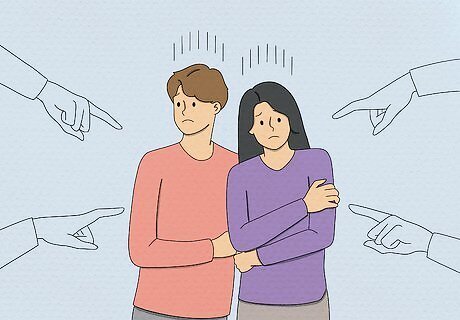
LGBT+ individuals are more likely to face discrimination. In some environments, there might be a lack of tolerance for the LGBTQIS-2 community. For example, LGBTQIS-2 youth might not have any role models to look up to and may only encounter heteronormative people and policies. In some cases, LGBTQIS-2 people might not have access to confidantes or support services. To cope with this situation, LGBTQIS-2 people might go online for a sense of connection or even isolate themselves. Certain environments might imply that people shouldn't address LGBTQIS-2 matters or may even ban these discussions. For example, certain regions might sign a bill that prohibits educators from talking about LGBTQIS-2 identities or rights. Some faith-based communities might shun LGBTQIS-2 individuals or attempt to "reform" them. In other settings, people's social programming might cause them to overlook LGBTQIS-2 people or exclude them. For example, certain kinds of work settings might celebrate a "traditional" and heteronormative brand of "masculinity."
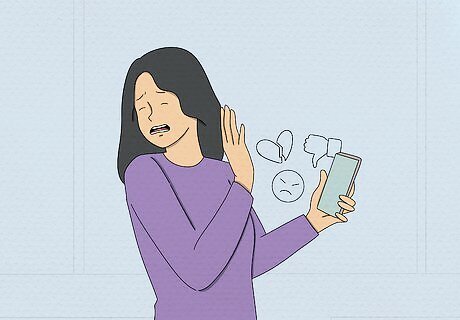
Hate speech is destructive to the wellbeing of LGBT+ people. Whether people intend their remarks to be damaging or not, any sentiments that poke fun at or ridicule LGBTQIS-2 individuals qualify as hate speech. They might be slurs, catch phrases, inside jokes, or political slogans that cast the LGBTQIS-2 community in a negative light. Any of this toxic rhetoric can drastically lower the self-esteem of LGBTQIS-2 people and perpetuate stereotypes about them. The more that people brush aside any anti-LGBTQIS-2 comments as "innocent jokes" or "passing remarks," the more that they normalize harmful rhetoric—it may even become everyday speech that LGBTQIS-2 people begin to regularly endure. Hate speech contributes to a culture of fear among LGBTQIS-2 people and increases the likelihood of hostility toward them. Studies have shown that victims of hate crimes reported hate speech in the past. Some countries have even criminalized hate speech in order to fight back against hate crimes.

LGBT+ people are at greater risk of isolation and mental health crises. Since LGBTQIS-2 individuals might encounter rejection and stigma, they're more likely to experience trauma and lower wellbeing. If you notice mental health crises among those who identify as LGBTQIS-2, express your concern to those in authority. Discuss policies and programs that can allow your community to intervene and offer support to LGBTQIS-2 individuals who are struggling. LGBTQIS-2 youth who are rejected by their family are eight times more likely to attempt suicide and three times as likely to use drugs than those who are accepted by their relatives. Studies show that LGBTQIS-2 individuals whose families express support experience lower levels of health risks and experience greater wellbeing than those from families that don't display tolerance. Anti-LGBTQIS-2 harassment also correlates with lower levels of academic success since LGBTQIS-2 students are more likely to skip class or even drop out of school.

Access to outreach organizations is crucial for LGBTQIS-2 youth. Since it can be difficult to navigate a heteronormative world, especially if the risk of harassment is high, make a list of LGBT+ support groups in your local area. If a young person who is LGBTQIS-2 tells you they need a safe space to express themselves, refer them to these organizations. Since they'll be staffed with adults trained to support the LGBTQIS-2 community, they can be instrumental for reducing any fear or stress LGBTQIS-2 people experience. If LGBTQIS-2 youth meet a whole group of trusted adults who celebrate their identity and provide counseling, they'll be able to experience greater levels of trust and wellbeing during an important developmental period of their lives. LGBTQIS-2 adults can benefit from mental health advocates and professionals, too—if anyone who is LGBTQIS-2 tells you they are struggling, suggest that they see a counselor who specializes in LGBTQIS-2 issues. The Trevor Project offers free support from trained counselors—LGBTQIS-2 individuals can call, text, or chat at any time of the day to express their concerns.
Being an Ally
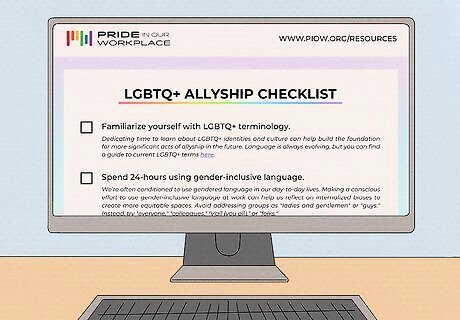
Assess your own beliefs and attitudes toward LGBT+ people. Consider whether you've been raised in a certain way or exposed to specific media that might've shaped your perception of the LGBTQIS-2 community. Even if you're well-meaning, you might have some assumptions about LGBTQIS-2 individuals, such as what they're interested in or how they want to be represented. To determine if you're ready to act as an ally, review a LGBTQ+ Allyship Checklist and see if you're following best practices. If you have questions about standards, like personal pronouns, visit a site like pronouns.org to keep up-to-date with proper etiquette. Continue to review the latest resources on allyship and attend community events that focus on LGBTQIS-2 advocacy to develop your awareness and sensitivity. Remember, it's okay to admit that you're still learning about the LGBTQIS-2 community and that it's a process for you.
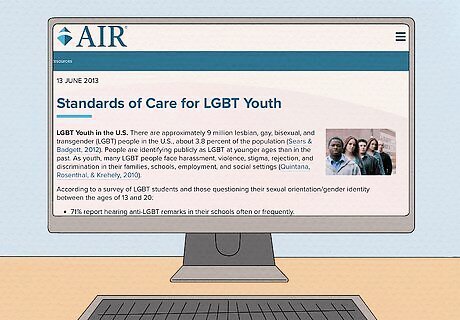
Create safe and welcoming spaces that support LGBT+ individuals. Implement the "standards of care," 10 ways in which organizations and systems can promote positive outcomes for LGBTQIS-2 youth—these include properly training staff and establishing anti-discrimination policies. If you are a community leader, announce that you are pro-LGBTQIS-2, address any anti-LGBTQIS-2 incidents, and intervene whenever you witness harassment. Educate others about negative behaviors, like hate speech or discrimination. Undergo professional development to increase your knowledge about how to support LGBTQIS-2 individuals and how to create safer work or educational environments. Attend speeches and informational events run by the LGBTQIS-2 community to better understand the needs and perspectives of LGBTQIS-2 people.

If LGBT+ people open up to you, promise to maintain confidentiality. It can be a deeply vulnerable moment for a LGBTQIS-2 individual to speak up about their experiences and adversities. Whenever they decide to do so, thank them for their bravery and reassure them that any information they disclosed is safe with you. Then, encourage them to speak to a trained counselor to benefit from additional support. To validate and affirm them, actively listen to their concerns. Wait for them to finish, then repeat back what you heard and empathize with them. Check in and ask if they want support in reporting any incidents of harassment or discrimination. If they ask you not to, respect their wishes. Remind them that you want them to be safe and point out the value in speaking to a mental health professional or a LGBTQIS-2 advocate.

Listen to the feedback and requests that LGBT+ people give you. Rather than trying to guess what the LGBTQIS-2 community expects from you, be receptive to LGBTQIS-2 individuals. Whenever they tell you about what they perceive as respect or what would give them a higher quality of life, take their perspective seriously. Even if you need to reevaluate your approach or the way you used to communicate with them, embrace this opportunity as a chance to demonstrate more tolerance. Consider insights from a broad spectrum of LGBTQIS-2 people—for example, listen to an older generation that can impart wisdom about their history as well as LGBTQIS-2 youth, who can discuss current concerns. If you've made a mistake—for example, maybe your school doesn't have clear language about anti-harassment policies—and a LGBTQIS-2 individual points this out to you, apologize and thank them for helping you grow.

Display symbols of LGBT+ acceptance to show you’re an ally. Openly demonstrate that you welcome LGBTQIS-2 individuals with images and messages that affirm their identity. For example, a "safe space" sign or rainbow flags are easy for LGBTQIS-2 people to recognize and lets them know they can arrive as themselves without any fear. If all of these symbols are visible throughout your community, then you'll foster an inviting atmosphere that can uplift LGBTQIS-2 individuals. Whenever you post pro-LGBTQIS-2 symbols, make sure that the places you direct LGBTQIS-2 people to are actually run by tolerant and respectful individuals. Display media that is inclusive of the LGBTQIS-2 community. For example, put up posters of same-sex parents, non-binary individuals, and LGBTQIS-2 role models.
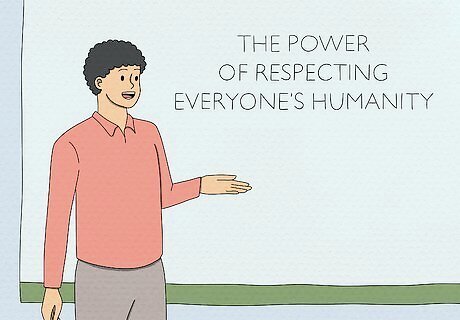
Encourage your network to be kind and respectful to LGBT+ people. Be open with your friends, colleagues, and relatives about your acceptance of the LGBTQIS-2 community. Speak about how everyone can do their part to be more welcoming—for example, create space in faith-based groups, family gatherings, and outings so LGBTQIS-2 individuals know they're valued and embraced. Discuss steps that would create a more inclusive environment. Your church might, for instance, deliver a sermon on the power of respecting everyone's humanity. Consider gestures that would be very meaningful for a LGBTQIS-2 individual. For example, if they've always wanted their relationship respected, invite their significant other over to take part in a family holiday. If your inner circle expresses reluctance, confusion, or ambivalence, reiterate your stance that you're tolerant of the LGBTQIS-2 community.
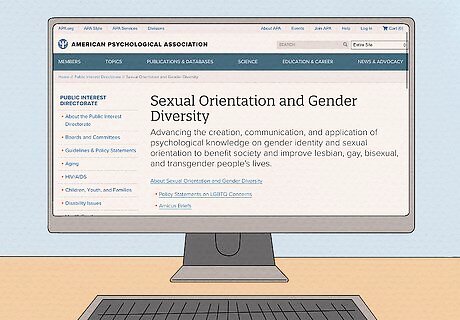
Share resources to help LGBT+ individuals find advocates. To make these sites and organizations accessible, post them in places that are clearly visible, such as a waiting room or an office. If a LGBTQIS-2 person discloses that they have an urgent concern, such as being displaced from their home after coming out to their family, immediately connect them with an organization that's trained to assist LGBTQIS-2 people who are experiencing a crisis. American Psychological Association's LGBT+ Resources: APA's page about biases, coming out, LGBT+ identity, and community outreach Center for Disease Control and Prevention's LGBT+ Resources: CDC's page on bullying, suicide prevention, and concerns for LGBT+ teens Family Acceptance Project: A foundation that educates families and faith-based communities about the mental health risks LGBT+ people face True Colors United: An organization with a special fund to help intervene when LGBT+ people experience homelessness Native Youth Sexual Health Network: Health resources for two-spirit and Native American youth Safe Schools Coalition: Workshops and resources to prevent anti-LGBT+ bullying and harassment in schools Human Rights Campaign Foundation: Resources on child welfare for LGBT+ youth, family acceptance, and professional development Lambda Legal: A civil rights organization with legal resources available for LGBT+ individuals and anyone living with HIV The Trevor Project & The Trevor Lifeline: A suicide prevention organization and a 24/7 free crisis hotline
Frequently Asked Questions
Do people need to have sexual interactions to find out their orientation? It's absolutely not a requirement to have sex to determine your sexual orientation, nor do specific sex acts dictate what a person's sexual orientation is. People come to terms with their sexual orientation in different contexts—some might have an awareness of theirs early on in life, while others realize who they're attracted to when they are older. All kinds of incidents can result in someone identifying their sexual orientation, from childhood crushes to ideas about who they want to date.
What is the gender binary? The "gender binary" is the concept that there are only two genders—male and female. Typically, "heteronormative" societies (communities in which heterosexuality is the norm) follow a gender binary. However, there are individuals who identify as neither male nor female and who do not refer to the gender binary to describe their identity. They may also call themselves "genderqueer," "agender," "bigender," or any other word that captures their internal sense of self. A person's gender can also be "fluid" and change over time.
Do gay or lesbian people have certain types of gender expression? There is no specific way that a gay or lesbian person acts, dresses, or speaks—a person's sexual orientation does not correlate with their gender expression. There may be, for instance, some gay people that describe themselves as more masculine, feminine, or gender-fluid, while lesbian individuals may similarly express themselves with varying degrees of masculinity, femininity, or gender-fluidity. Above all, gender expression is unique to each person, regardless of who they're attracted to.
Will bisexual people eventually identify as straight, gay or lesbian? It is a myth and a stereotype that bisexual individuals haven't "decided" whether they're gay or lesbian yet. This is also a harmful belief because it perpetuates the idea of "bisexual confusion," in which bisexual people are described as unsure or just in the middle of a phase. Those who are bisexual also endure claims that they're "promiscuous" because they experience attraction to both genders. If a person identifies as bisexual, then they are expressing a valid truth about themselves. Further, bisexual people are equally as capable of being faithful as anyone else.
Can LGBT+ people have families? Absolutely! Many LGBT+ individuals cohabitate with each other, are part of happy relationship dynamics, and choose to start their own family units. As the social climate has become more accepting of LGBT+ people, more LGBT+ families have been able to be open about their lives. Additionally, many LGBT+ people are very invested in family planning—LGBT+ people are six times more likely to foster children and four times more likely to adopt children than their non-LGBT+ counterparts.
Can LGBT+ individuals participate in faith communities? Many LGBT+ people have rich religious lives and are deeply spiritual—however, others may feel more reluctant to be active in faith communities due to the discrimination or social ostracization they endured. Today, there are specific denominations, like Reform Judaism and the Episcopalian church, that are openly supportive of the LGBT+ community. Ultimately, LGBT+ individuals are free to follow their religious beliefs and are best served by faith-based communities that are vocal about including them.




















Comments
0 comment